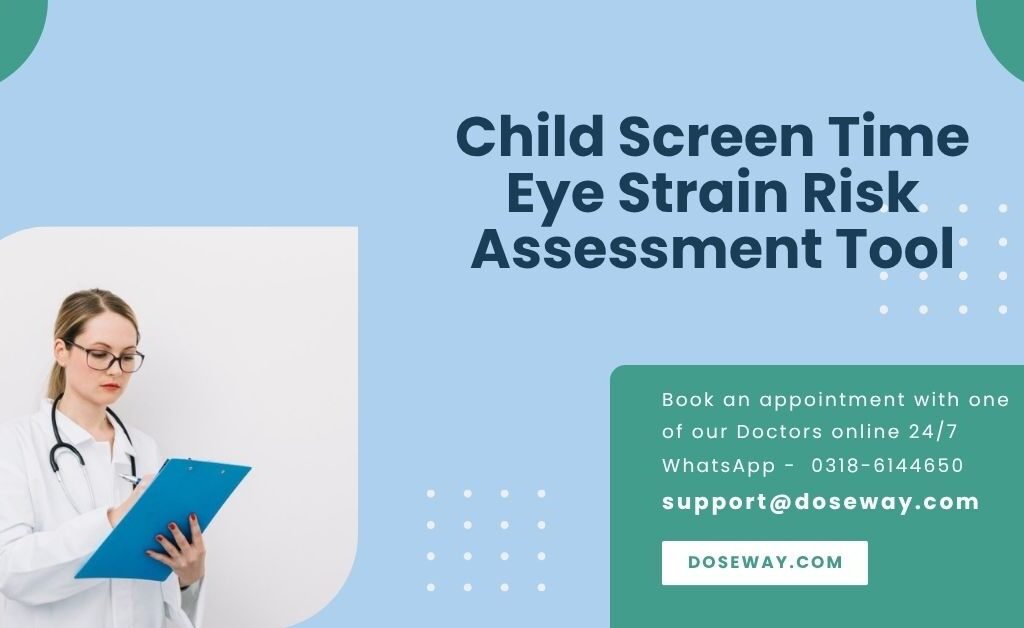Child Screen Time Eye Strain Risk Assessment
Personal Information
Screen Time Habits
Assessment Results
Try More Free Tools:

Table Of Contents
Free Child Eye Strain Risk Calculator: Assess Digital Eye Strain Symptoms & Prevention
Digital Eye Strain (DES) – also called Computer Vision Syndrome – is a medical condition caused by prolonged screen exposure. It affects 60% of adults and 30% of children according to the American Optometric Association. When children spend >2 hours daily on screens, their risk increases dramatically due to:
- Underdeveloped eye muscles
- Reduced blink rates (50% less when using screens)
- Higher susceptibility to blue light damage
Symptoms of Digital Eye Strain in Children
Recognizing these signs early prevents long-term vision damage:
| Symptom Type | Common Manifestations |
|---|---|
| Visual | Blurred vision, double vision, difficulty focusing |
| Physical | Headaches, neck/shoulder pain, eye fatigue |
| Ocular | Dry/red eyes, burning sensation, light sensitivity |
Diagnosis Procedures
1. Comprehensive Eye Exam
Includes:
- Visual acuity test (Snellen chart)
- Refraction assessment (phoropter)
- Binocular vision testing (cover test)
2. Digital Usage History
Ophthalmologists evaluate:
- Daily screen time
- Device types (LED vs. LCD)
- Viewing distances
3. Tear Film Evaluation
Uses Schirmer’s test to measure dry eye severity.
Treatment Options
Immediate Relief
- Artificial tears (preservative-free lubricants)
- Blue light glasses (block 400-455nm wavelengths)
- Warm compresses
Long-Term Solutions
- Vision therapy: Eye muscle strengthening exercises
- Prescription lenses: Anti-reflective coatings
- Screen filters: Matte anti-glare protectors
Critical Prevention Strategies
- 20-20-20 Rule: Every 20 minutes, look 20 feet away for 20 seconds
- Optimal Screen Positioning:
- Distance = 1.5x screen diagonal size
- Top of screen at/below eye level
- Ambient Lighting: 50-100 lux brightness (match room/screen)
- Blink Training: Conscious blinking every 4 seconds
- Annual Eye Exams: Mandatory for school-aged children
How Our Child Eye Strain Risk Calculator Works
This tool calculates risk using evidence-based parameters:
Input Variables & Clinical Significance
| Parameter | Medical Relevance |
|---|---|
| Screen Time | >2 hrs/day ↑ risk of myopia progression (NIH Study 2023) |
| Viewing Distance | <40cm causes 3x greater accommodative stress |
| Brightness Level | High blue light ↓ melatonin & disrupts sleep cycles |
| Break Frequency | Regular breaks ↓ dry eye symptoms by 78% |
Calculation Methodology
Risk Score =(Screen Time × 3) + (Distance Penalty) + (Brightness Score) - (Break Bonus)
Interpreting Your Results
Risk Levels & Action Steps
| Score Range | Color Code | Interpretation |
|---|---|---|
| 0-30% | Green | Minimal risk → Maintain habits |
| 31-70% | Yellow | Moderate risk → Implement 20-20-20 rule |
| 71-100% | Red | High risk → Consult pediatric ophthalmologist |
Example Output:
*"Your child has HIGH risk (82%) due to 5-hour daily screen use and <30cm viewing distance. Recommendation: Schedule eye exam + reduce screen time to <2 hours."
Why This Calculator Matters
Early detection prevents:
- Permanent refractive errors
- Reduced academic performance
- Chronic migraine disorders
One in four children has undiagnosed vision problems that affect learning (CDC Report).
Save Your Customized Report
Click "Save as PDF" to download:
- Personalized risk assessment
- Symptom checklist
- Ophthalmologist discussion guide
- Emergency contact list
Disclaimer: This calculator provides preliminary screening only. Consult a licensed ophthalmologist for medical diagnosis.
Frequently Asked Questions (FAQs)
Q: How does screen time cause myopia?
A: Prolonged near-focusing elongates eyeballs. Each extra hour ↑ increases myopia risk by 5% (BMJ Study).
Q: Do blue light glasses work for children?
A: Yes – studies show 32% symptom reduction when worn consistently (JAMA Ophthalmology).
Q: At what age can children start using screens?
A: The American Academy of Pediatrics recommends:
0-18 months: Zero screens (except video calls)
18-24 months: Limited co-viewing
2-5 years: ≤1 hour/day

 Cart is empty
Cart is empty
Add a Comment